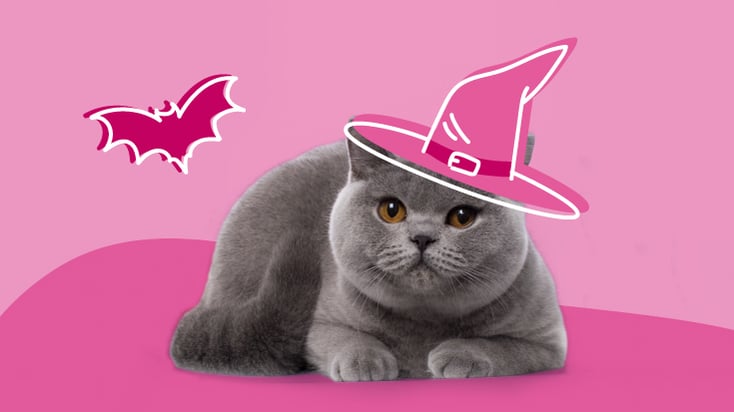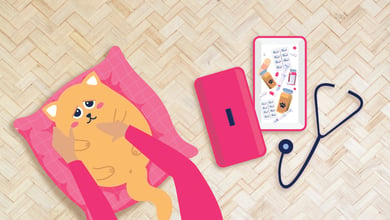Halloween Pet Safety: 8 Tips to Keep Your Pets Secure

Table of Contents
Halloween means time for fun and games for many of us. However, as much as it can be a ghostly good time for you, this might not be the case for your pets. After all, the sound of doorbells and strangers knocking might be distressing to your four-legged friends.
To ensure everyone has a fabulously fun time, make Halloween pet safety a priority. Provide a cozy hiding place, like a quiet bedroom or home office, to keep your dogs, cats, and other pets from all the commotion and activity at the front door.
Here's a list of Halloween pet safety tips to help keep your pet safe on Halloween and throughout the holiday season.
1. Decoration Dangers
Without decorations, Halloween wouldn't be colorful and fun. However, be careful with these decorations for the sake of your pets.
If your kids will be playing with glow sticks, don't let your pets get close to them. Glow sticks contain an oily liquid (dibutyl phthalate), which, according to the Pet Poison Helpline, is toxic (although rarely deadly) and can cause pets to drool, foam at the mouth, and possibly vomit if they chew one.
Other potentially harmful decorations are rubber eyeballs, fake cobwebs, strung lights, fake blood, and potpourri.
Consider making pet-friendly decor instead. For instance, create a haunted house made of cardboard for your feline friend, then put safe treats and toys inside.
Are You a Pet Safety Expert?
1. Which one of the plants below is toxic to cats if ingested?
2. Which of the foods below is generally considered safe for your dog to eat?
3. Above what temperature is too hot to leave a pet in your car?
4. Which kind of leash is the safest to walk your dog?
5. True or False: If a medication is safe for humans, it is probably safe for pets.
6. What should you do if you think your pet ate something toxic?
View Results
Are You a Pet Safety Expert?
1. Which one of the plants below is toxic to cats if ingested?
2. Which of the foods below is generally considered safe for your dog to eat?
3. Above what temperature is too hot to leave a pet in your car?
4. Which kind of leash is the safest to walk your dog?
5. True or False: If a medication is safe for humans, it is probably safe for pets.
6. What should you do if you think your pet ate something toxic?
Share Quiz
2. Keep Electrical Cords and Wires Out of Reach
If you're decorating your house for celebrations, make sure to keep electrical cords or devices and batteries out of the reach of your dogs and cats. Your pets might chew on the cords (especially if they're stressed) or ingest batteries, which can be fatal. If it's impossible to keep the wires above pet level, ensure your pet is supervised in that area.
3. Protect Your Pet From Burns
Candles and Jack-o-lanterns are part of Halloween decorations. Your pet should be kept away to avoid the risk of singed whiskers, getting burned, or causing a fire. If it's tricky to keep them away from lit candles, an alternative is electric candles.
Children love playing with sparklers, but they should be careful as they're scary to some pets. While using them, ensure your pets are indoors. Always dip the sparklers in water before discarding them to make sure they're extinguished.
4. Keep Treats Out of Reach
Edible Halloween treats are always part of the celebrations. You might be tempted to share your treats with your pet during trick or treating, but this is not advisable. Cats and dogs must not be given chocolate and candy. Chocolate toxicity is a real danger for your pet, and you should call a veterinarian immediately if your pet consumes even a small amount of chocolate.
Hassle-free In-Home Pet Sick Visits
When your pet isn't feeling well, the last thing you want is a stressful trip to the vet. Our in-home sick pet visits offer a calm, stress-free alternative.
Pumpkin pie is often on a Halloween menu, and although pure, natural pumpkin can be good for your pet, pumpkin pie is not. The spices, sugar or artificial sweeteners, and high-fat content can cause distress in their intestinal tracts.
Other treats, such as candy, should also be kept out of reach. Sugar-free candy and gums contain Xylitol, a sugar substitute that can cause severe hypoglycemia and life-threatening liver failure.
Halloween pet safety also involves safely discarding trash that may be a choking hazard. Candy wrappers ingestion is a common problem for dogs, so keep them out of reach.
5. Your Costume
Halloween themes are spooky! When you or your family members step into costumes with masks, unusual make-up, or other elements that dramatically change your appearance, the unfamiliar visuals combined with the rustling sounds of costumes might not just spook the neighbors.
Such sights and sounds can be jarring for pets, making them feel surrounded by strangers rather than their loved ones. To keep them calm and avoid any startled reactions, it's a good idea to place your pets in a familiar, safe room before you dive into the Halloween festivities.
6. Pet Costumes Are Cute but Can Be Dangerous
You also need to be careful with pet costumes. A dressed-up pet is likely to feel stressed, as wearing clothing can limit their movements, breathing, or vision. If your pet doesn't enjoy wearing a costume, don't dress them in one.
Always check if your pet's costume has choking hazards and fits properly. This will prevent the extra cloth of a poorly fitting costume from becoming entangled and causing injury to your pet.
If you have to dress your pet up, perhaps for a pet parade or special party, consider these Halloween safety tips for pets' costumes.
- The attire should be comfortable.
- The costume should not block your pet's ability to hear, see, breathe, eat, or move around.
- There should not be excess material that could tempt chewing and cause choking or fire hazards.
Take time to let your pet get comfortable in the costume before Halloween. Keep an eye on your costumed pet for signs of discomfort, such as a tucked tail, dilated eyes, tense posture, or folded back ears.
7. Ensure Pet IDs and Collars Are Updated
Due to the activities in and around your home, your pet might become anxious or spooked and behave differently. While you're preoccupied with trick-or-treaters, they may escape through an open door. Using services like mobile pet microchipping, an ID tag, and a collar can be invaluable in tracing your lost pet or allowing someone to contact you. Double-check that the microchip details and your contact number on their pet identification tags are up to date.
8. Keep Anxious Pets Calm During Activities
Noise anxiety can make Halloween a nightmare for pets. Before you start your Halloween trick-or-treating, move your pets to a quiet, separate room, distant from Halloween activities. Put a sign on the door that it is off-limits, and give them their favorite toys. You can also play soft music and consider sitting outdoors to minimize doorbell stress and knocking.
If your pet gets anxious from loud noises, you can speak to your veterinarian about prescriptions that can help to reduce anxiety such as Trazodone. While these measures don't work overnight, they can be worth starting so that your dog or cat gradually learns that these sounds are not dangerous.
Conclusion
It's important to prioritize pet safety for Halloween festivities. After all, their normal daily activities are being disrupted, and their home is getting invaded!
Cats are fond of staying quietly indoors in cozy hideouts, but due to the frequent guests, they may get stressed and run out as guests come in. Many dogs become rowdy due to unfamiliar faces and costumes. Secure a quiet place for them away from Halloween activities to reduce anxiety.
If your dog or cat is noise-tolerant and will participate actively, consider their safety. Ensure they're on a secure leash and protect them from kids who may want to pet them.
We hope our Halloween safety tips help you keep your pets safe. For more information on pet safety or care, book a home vet visit.




